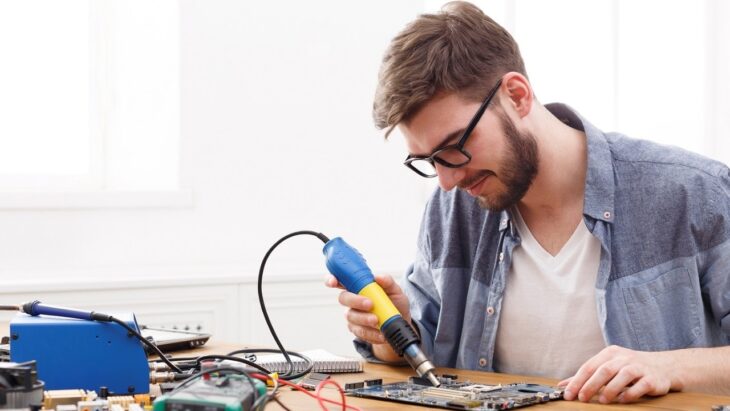Electrical Engineering is the area of study that relates to electricity used in equipment, devices, or systems that rely on electric circuits to work. The United States Bureau of Labor and Statistics claims that employment in this field will increase by 3% over the next decade. A beginner’s guide, or crash course as you could say, revolves around the basic concepts and laws that apply to the field. Without knowing and understanding them this section of engineering will be impossible to learn.

Source: esa.int
- Basics of Electricity-In order to understand any laws, equations, or concepts of Electrical Engineering you must first have a solid understanding of electricity. The electric charge is created by the protons and neutrons and is described as the flow of electrons which are negatively charged particles. Current is measured in amperes. The electric current is the static charge that flows in a specified direction. The current can flow easily through conductors but are stopped from flowing through with insulators. The electric circuit is the entire loop. The negative electrons flow through the wires in a loop because they are attracted to the positive neutrons. This loop can be constant or turned off with some form of insulator, such as when turning off a light switch.
- Ohm’s Law- Ohm’s Law states “that the current through a conductor between two points is directly proportional to the voltage over the resistance”. It may be easier to understand in mathematical terms. The basic formula is V=IR. V is the voltage in volts. I is for the current in amperes. R is for the resistance in ohms. To put this in easy-to-understand terms this law will allow you to figure out any part of the circuit if you know the amounts of two of the parts. If you decrease the volts through the current the resistance will go down. If you increase the volts, the resistance will go up. Voltage is the starting point of a circuit. This amount is what pushes the current through. The resistance that is placed onto the current lowers the number of amps through the circuit, making it the amount needed to run a specific machine or device.
- Faraday’s Law-This is most known as the Law of Induction. It is how an electrical current produces a magnetic field, and how a magnetic field that is changed will generate a current within a conductor. All modern electric motors, generators, and transforming work because of this law. All these items work off magnets which cause a magnetic field. There is a north and south end, positive and negative, which pulls the magnetic flux around in a loop. The negative is pulled to the positive, and the positive sends the current back down to the south end, starting the loop all over again. To go more into depth with this law, or any of the others, visit this site.

Source: worldscholarshipforum.com
- Kirchoff’s Laws-Kirchoff’s Current Law (KCL) states “total current or charge entering a junction or node is exactly equal to the charge leaving the node as it has no other place to go except to leave, as no charge is lost within the node”. This simply means that the current that flows through a wire will continue at the same ampere when it leaves a junction. Kirchoff’s Voltage Law (KVL), states that “in any closed-loop network, the total voltage around the loop is equal to the sum of all the voltage drops within the same loop”. This means that the amperes of the current as it ends will be the starting amount minus any drops through the loop. If all the components in a loop are connected, they are said to be in a series. If currents are of the same voltage but not connected, they are said to be parallel. Basically, if you have a wire that comes out of the fuse box, connects to numerous lights and outlets, and then returns to the fuse box, the circuit would be in a series. If each light and outlet were wired separately, they would be parallel.
- Star Delta Concept-In a 3-way circuit the Star and the Delta connections will have to be used and understood. The Star circuit is set up with a four-wire system, while the Delta circuit is set up by using three. The Star circuit is made of four wires, using one as a neutral, or ground wire as it is commonly called. The Delta circuit is made up of three wires and does not use a neutral wire. In both circuits, the wires come out from a set location and fan out to form the loop. The Star concept is more commonly called a Y circuit and is used for transmission or distribution networks. The Delta version is used for distribution networks only and are mostly used for short-distance circuits.

Source: unitec.ac.nz
As you can see electrical engineering is a complicated mix of knowledge and understanding. This can be complicated if you do not comprehend the basic concepts of electricity. After that is learned, and you have a working knowledge of it, then all the laws must be put into practice through various circuits. Machines and equipment all run off the basic knowledge explained above. If you break down each type of circuit, how much amperes you need on it, how many drops you have, and how to connect the loop, you will have the know-how to wire circuits and to repair them if needed.
To work in the Electrical Engineering field, you must have an advanced education. A Masters degree would teach you all the information that you need to know, and more. You could easily become the top electrical engineer in your area with online education, such as the link that I provided for you above. Working in the field with other professionals will help you learn the basics, and even advanced techniques, while you gain a degree through an online portal. There will always be a need for people in this profession. The more that society moves in the direction of technology, the more jobs will open in the field.
